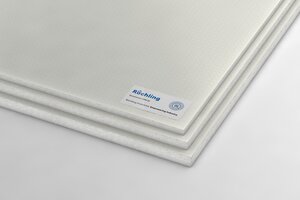Clean Factory
In Neuhaus in the German state of Thuringia, we manufacture several millions containers for very special active ingredients every year. The final products are only a few centimeters long, but their production requires high manufacturing technology, ultra-clean conditions, extensive hygiene measures and strict controls.
Every morning when he comes to work, Ali Silay steps into another world. But stepping inside isn’t as easy as it sounds. When Silay arrives at the building on the Röchling site in Neuhaus, he first has to take off his shoes and put on a pair of black transfer shoes. Then he goes through a door into the first gowning room. There he has to strip down to his underpants, wash and disinfect his hands, put on a hood, beard protection, clean room underwear and socks and swing over a bench (called a sitover), changing his transfer shoes in the process. Next he must disinfect the safety shoes for the next area, put on a half-length lab coat and pants, take off his transfer shoes, put on the disinfected shoes and disinfect his hands again. And that’s just the beginning. Like a castle, the facility has several defensive walls in order to keep out all kinds of contaminants.

Good manufacturing practices
On he goes to the next personnel lock, where he disinfects his next pair of transfer shoes, takes off the lab coat and once again washes and disinfects his hands. In front of the marked area, he takes off his safety shoes and puts on the third pair of transfer shoes, which is deposited behind the marking. He takes the next pair of safety shoes off the shelf and disinfects both the shoes and his hands. Now the airlock awaits him, which means he has to put on an overall and a face mask, take off the third pair of transfer shoes, put on safety shoes and step over the marking. Another sitover and a final hand disinfection, then Ali Silay can pass through the airlock and is actually inside – in another world, in his world, because here he bears responsibility. Ali Silay, 41 years old, with dark hair, alert eyes and a friendly voice, is production manager in a clean room that conforms to GMP class C. GMP stands for “good manufacturing practices” and is an EU standard for the classification of clean rooms. The class C production hall in which Silay is standing has a number of distinctive characteristics – such as the air, which is particularly low in particles. No more than 3,520,000 particles with a maximum diameter of 0.5 micrometers (µm) and no more than 29,000 particles larger than 5.0 µm may circulate here per cubic meter (m³) of air. That may sound like a lot, but out in the open air or in the cafeteria, you sometimes find hundreds of millions of particles.
Wood? Then the traffic light for air purity would immediately turn red
Almost everything here in the clean room is made of stainless steel. “The equipment is designed, constructed and used in such a way as to minimize the risk of errors and to permit thorough cleaning and maintenance in order to avoid any pollution or contamination. Wood, for example, is an absolute no-go because of the small particles it can release,” says Ali Silay through his beard protection, while the machines run smoothly in the background. The rooms are monitored using traffic lights with the usual colors of red, yellow and green. They can be found in every room, each connected to a sensor that determines the current level of particles in the air as well the humidity, temperature and room pressure. In addition, there is a higher air pressure in areas with GMP class C than those with GMP class D (see box). “This prevents particles from getting in from the outside,” explains Silay. But why exactly is that necessary? What is there in this hall that needs to be protected from even the tiniest particles of dirt?
It’s all about a small plastic container weighing about 2 grams
Your eyes are immediately drawn to the machines. There are two of them, each as big as a truck. Several connections protrude from them and disappear into the wall. The machines both stand in a spacious, hall-like area. Almost every second a small object comes out of the machines – or to be precise, it slides down a slide and lands in a clean bag. This is the object it’s all about, the reason why the air has to be so clean and why the multi-million euro building in Neuhaus was erected in 2018.
At first glance, the object is quite unspectacular: a small plastic container weighing about 2 grams. But in its future place of deployment, it plays an important role: It is the centerpiece of small inhalers for people with respiratory diseases. Pharmaceutical customers of Röchling Medical fill the plastic containers with an active ingredient that helps people breathe again after inhaling it.
Even a small hair can cause major problems
Users breathe the contents of the container deep down into their lungs. “A piece of hair, for example – even if it’s just a tiny fragment – can cause major problems,” Silay explains. That is why as many processes as possible have been automated here. At the same time, there is a small team that works here in one shift. It doesn’t take more than a few employees to keep production up and running – and that’s a good thing, since all humans spew huge quantities of particles. “We have to protect the container from people so that the container and its contents can later protect other people,” says Ali Silay.

The production materials also have to pass through strict hygiene locks
Not only people are subject to strict entrance controls and hygiene locks; even raw materials must pass through them. They arrive in the form of small pellets, each three to four millimeters (mm) in diameter. Sacks of this granulated material enter the clean room through a lock, where they are collected by the employees, carefully disinfected and finally filled into a raw material container: a kind of funnel that is directly connected to the machines. From there, a vacuum conveyor system sucks in the material and transports it to the machines. The tiny pellets are melted and then shaped into containers. But clean people and clean raw materials are not quite enough. It could theoretically be possible that a particle, such as the tip of a hair, somehow reaches a plastic container. Or that the container does not have exactly the dimensions or function it is supposed to have. This can lead to the inhalers not working properly and releasing less medication per stroke than they should – which can have serious consequences in the case of acute respiratory diseases.
Perhaps the toughest quality control in Germany
For this reason, the plastic containers are subjected to a rigorous inspection after the first production steps. When the bag of newly produced containers is full, an employee transfers it to another room. Here the small containers are placed on a conveyor belt that transports them through a labyrinth in a flashing chamber, where cameras inspect all surfaces. If one of them detects an irregularity, the container is ejected. This is perhaps the toughest quality control in Germany – or even Europe.
Several times a day, one or more containers are sorted out. Depending on how often this happens, the employees know whether there is a problem with the system or whether the container is simply a normal reject.

Right: One out of every two thousand products is subjected to a thorough quality inspection under the microscope.
Deviations of just a few hundredths of a gram are enough to discard a container
Once 2,000 containers have been produced, several sample containers are automatically ejected, and an employee takes them to a laboratory that is also part of the clean room area. There the employee examines whether all of the desired parameters are met: The weight may only deviate from the reference value by a few hundredths of a gram; likewise, there are only narrow tolerance ranges for the collar height and the thickness of the inner layer. If the deviation is too large, the plastic containers produced since the last positive sample are discarded and the search for the source of the error begins. This happens very rarely though.
“There are times when the work here can be a little one-sided. But at the same time, you have great responsibility – and you work in a highly professional environment. So I consider it a privilege to be able to accompany the production here,” says Silay.
Packaging followed by sterilization
Once the plastic containers have successfully passed all quality inspections and been processed further, they fall into a sterile transport bag. When the bag is full, an employee seals it.
But a full and sealed bag doesn’t mean it's over. One side of the bag is processed so that it is permeable to gas. The contents – around 4,000 containers – are then fully sterilized once again.
Several million containers are produced in Neuhaus every year. After being sterilized, several hundred thousand containers are delivered in one batch to our customer for filling.

Once every second, someone somewhere uses an inhaler with a small plastic container made in Neuhaus
If you convert this to consumers and patients, you find that, more than once a second on average, someone somewhere in the world uses an inhaler whose small plastic container was made in Neuhaus am Rennweg under Ali Silay’s supervision.
That thought makes Silay proud. “Thanks to our state-of-the-art inspections, I know for sure that only first-class goods leave our company,” says Silay. Only these goods make it out of the factory for further processing – and finally to the patient.

Some products must be manufactured under particularly clean conditions. This applies especially to the life sciences and semiconductor technology, but also to aerospace technology, certain foodstuffs and nanotechnology. There are different clean room classes, which are assigned in line the EU GMP Guidelines (GMP = good manufacturing practices) as follows:
Class | Number of particles with a diameter equal to or greater than 5 micrometers |
| A | 20 |
| B | 29 |
| C | 2900 |
| D | 29000 |
When it comes producing sterile drugs (pharmaceuticals), four clean room classes normally apply to the production areas according to Annex 1 of the EU GMP Guidelines. The following table shows the classification based on the particles contained in the air.
EU GMP class | at rest | in operation | |||
| Max. number of particles permitted per m3 (equal to or greater than) | |||||
0,5 µm | 5,0 µm | 0,5 µm | 5,0 µm | ||
A | 3.520 | 20 | 3.520 | 20 | |
B | 3.520 | 29 | 352.000 | 2.900 | |
C | 352.000 | 2.900 | 3.520.000 | 29.000 | |
D | 3.520.000 | 29.000 | not specified | not specified | |











